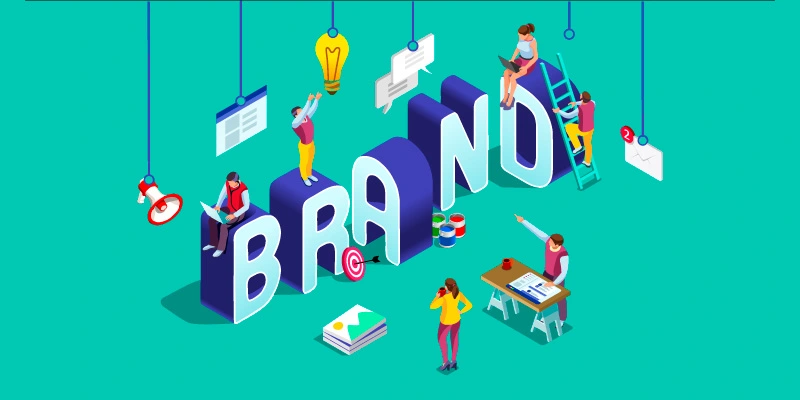Branding is “the process of giving a corporation a particular design or symbol in order to sell its products and services.” This used to be a fairly true description of branding, at least according to the prevailing opinion.
Due to branding’s reduction to its aesthetic component, visual identity, it was (and still is) wrongly interpreted. Branding is still seen by many people, experts or not, as merely referring to the visual identity, such as the name, logo, design, packaging, etc. Even high-level marketers are preaching the same outdated conception of branding, despite the fact that the idea of branding and our knowledge of it have changed significantly over time.
Brands are essentially mental representations of patterns that people have for familiarity, meaning, affection, and assurance. The importance of branding can be attributed to the fact that it not only helps to leave a lasting impression on consumers but also informs them about what to anticipate from your business. It is a strategy for standing out from the competition and emphasizing what it is about what you have to offer that makes you the better option. Your brand is created to be an accurate reflection of your company’s identity and desired public perception.
A brand is developed in many different ways, including through advertising, customer service, social responsibility, reputation, and graphics. All of these components, along with many more, come together to form a singular and, ideally, captivating profile.
What makes branding so essential?
Given the overall effect it has on your organization, branding is vitally essential. In addition to influencing consumer perceptions, generating new business, and boosting brand value, branding can also have the reverse effect if done wrongly.

1.Branding raises the value of a company.
A good brand can boost a business’ worth by providing it greater clout in the market, which is vital when trying to generate future business. Due to its established position in the market, it becomes a more alluring investment prospect.
2. Branding attracts new clients.
It won’t be difficult for a strong brand to generate referral business. Customers are more inclined to do business with you if your firm has strong branding because of the familiarity and implied dependability of employing a name they know and trust. Once a brand is well-known, word-of-mouth marketing will be the greatest and most successful strategy used by the business.
3. Enhances pride and satisfaction among employees.
Employees who work for organisations with strong brands and who genuinely support those brands will be happier in their roles and take greater satisfaction in the work they produce. Working for a company that has a well-known brand that the public respects makes working there more meaningful and enjoyable.

Practice of branding.
Branding is most definitely not a one-page subject. It is a subject that is always changing and touches on many fields of knowledge, including business management, marketing, advertising, design, psychology, and others. Additionally, branding has several layers, each with its own structure and meaning. Although it differs from marketing, the two share a lot of similarities. Therefore, we cannot accept or reject the idea that branding and marketing are in any way related to one another. They are interconnected, and business is their main priority.
How to effectively brand your business
1. Analyze your target market and rivals.
Understand the present market, including your potential clients and rivals, before you begin making judgments about how to build a business brand.
2. Determine your personality and focus.
In particular at first, you can’t build your brand to be everything to everyone. As you construct your brand, it’s important to identify your emphasis and let that guide all of the other components.
3. Select a name for your company.
What’s in a name? You can argue that your name matters a lot or a lot less depending on the type of business you intend to launch.
A brand is much more than just a name, as we’ve already stated. What gives your brand identity’s name true market meaning are its character, deeds, and reputation.
However, one of the first significant decisions you must make as a small business owner is likely the name of your enterprise. It will have an effect on your brand’s logo, URL, marketing, and trademark registration.
4. Compose a tagline
A snappy slogan is a nice-to-have item that you can use as a tagline in your social media bios, website header, bespoke business cards, and anywhere else where you have limited space to create a great impression. A strong tagline increases brand awareness by being brief, memorable, and noteworthy.
5. Decide on your brand's appearance (colours and font)
Once you’ve settled on a name, you should consider your brand design, including your colour scheme and typography, to determine how you will visually represent your company. When you start using a website builder to create your own website, this will be useful.
6. Create your company's logo
One of the first things that undoubtedly comes to mind when you consider creating a new brand is a brand logo design. And for good reason—after all, it serves as the public face of your business and may be seen wherever your brand is present. Ideally, you’ll want to develop a distinctive logo for your brand.
7. Integrate your company's branding throughout.
By using your branding throughout your company, you may create a unified brand narrative. A brand story encapsulates the essence of your company and its values. Every customer engagement with your brand, both in-person and online, is set up by this.
Adapt your brand as you expand
The process of developing a brand does not end with the creation of a logo, tagline, or even with your launch of brand awareness. Anywhere your clients contact you, from the design of your website to the promotional materials you create to how you package and ship your goods, your brand needs to be present and consistent.
As you expose more customers to your brand, learn more about your target audience, and develop effective communication strategies, you’ll continue to mould and evolve its style and identity.

